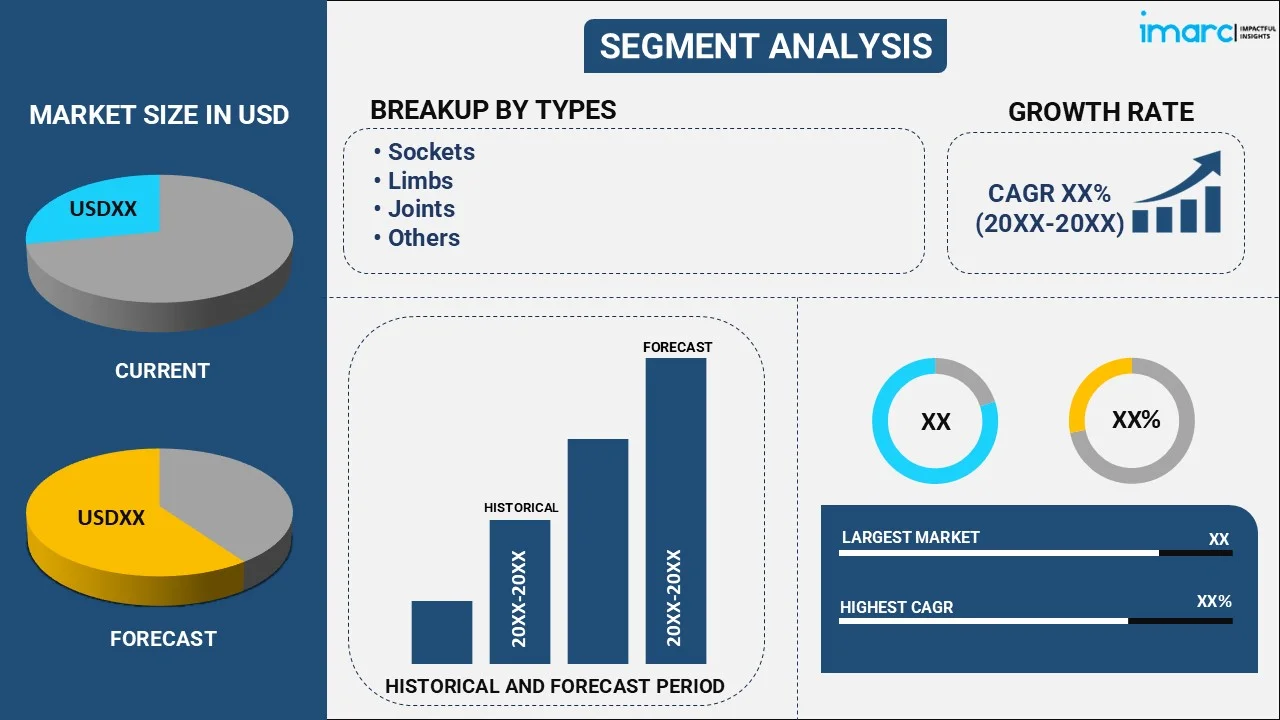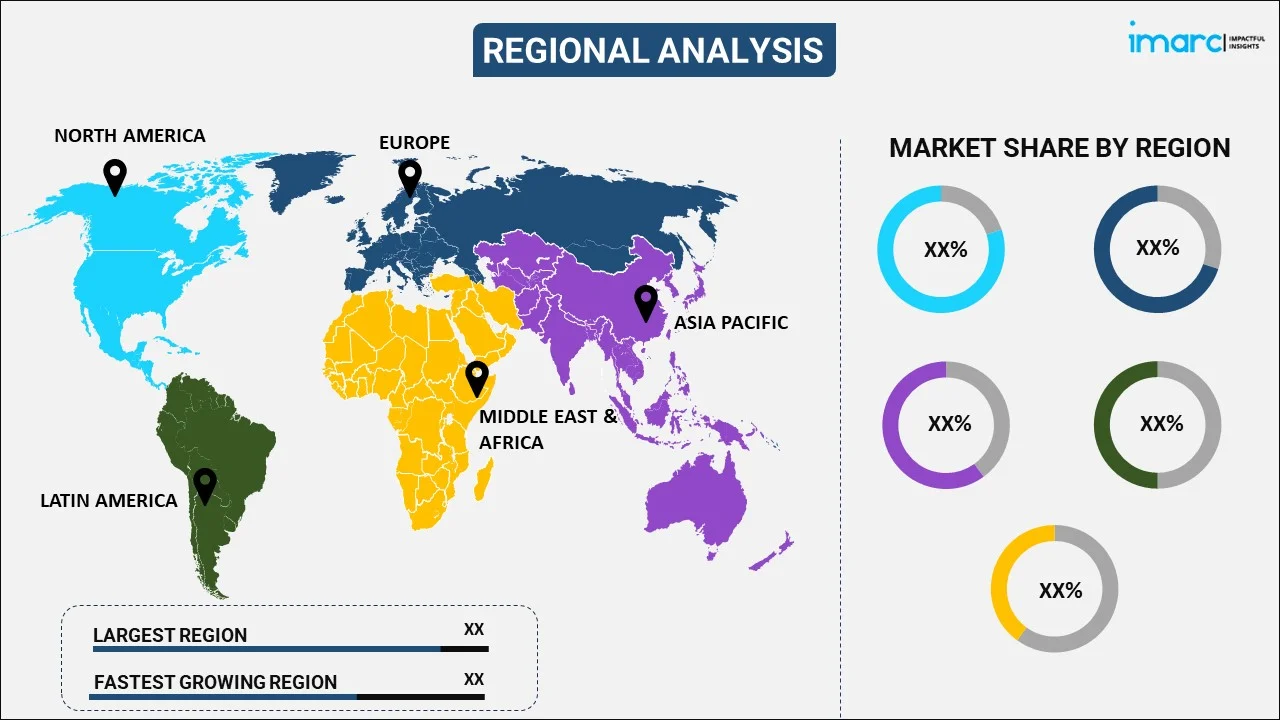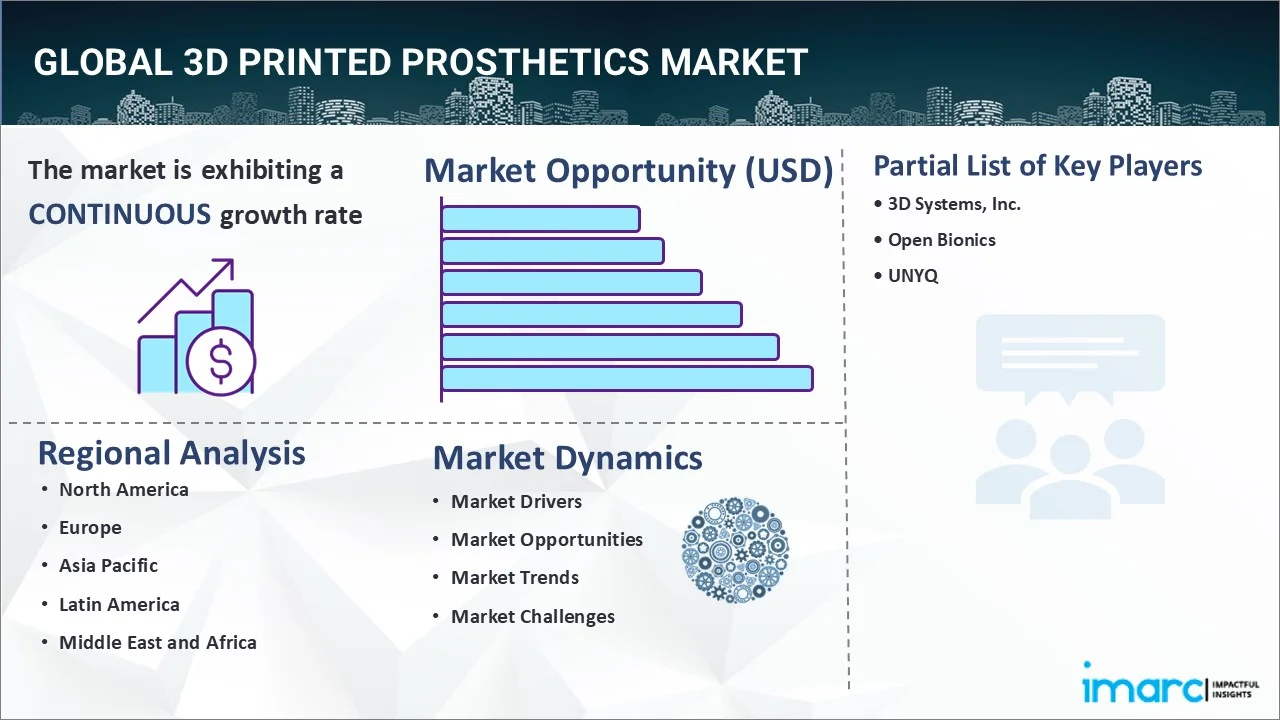
3D Printed Prosthetics Market Report by Type (Sockets, Limbs, Joints, and Others), Material (Polyethylene, Polypropylene, Acrylics, Polyurethane), End User (Hospitals, Rehabilitation Centers, Prosthetic Clinics), and Region 2025-2033
3D Printed Prosthetics Market Size:
The global 3D printed prosthetics market size reached USD 1.12 Billion in 2024. Looking forward, IMARC Group expects the market to reach USD 1.99 Billion by 2033, exhibiting a growth rate (CAGR) of 6.04% during 2025-2033. Rapid technological advancements, increasing incidences of amputation, significant growth in the healthcare industry, rising demand for 3D printed pediatric prosthetics, and imposition of supportive policies by several governments across the globe are some of the major factors propelling the market.
|
Report Attribute
|
Key Statistics
|
|---|---|
|
Base Year
|
2024 |
|
Forecast Years
|
2025-2033
|
|
Historical Years
|
2019-2024
|
| Market Size in 2024 | USD 1.12 Billion |
| Market Forecast in 2033 | USD 1.99 Billion |
| Market Growth Rate 2025-2033 | 6.04% |
3D Printed Prosthetics Market Analysis:
- Market Growth and Size: The global 3D printed prosthetics market is experiencing moderate growth, driven by factors like the increasing demand for personalized medical devices and rising incidences of orthopedic conditions.
- Major Market Drivers: Key drivers include the need for affordable prosthetic solutions and the customization potential of 3D printing technology. These factors are revolutionizing prosthetic design and manufacturing, making prosthetics more accessible and tailored to individual needs.
- Technological Advancements: Innovations in 3D printing materials and techniques, along with increasing healthcare expenditure and supportive government initiatives, are enabling the creation of more durable, lightweight, and realistic prosthetic limbs.
- Key Market Trends: There is a noticeable shift towards biocompatible materials and the integration of electronics for enhanced functionality, marking significant trends in the market. These advancements are improving the comfort, durability, and lifelike appearance of prosthetic limbs.
- Geographical Trends: North America dominates the market, driven by advanced healthcare infrastructure, high healthcare spending, and strong presence of key industry players. However, Asia Pacific is emerging as a fast-growing market on account of the increasing healthcare investments, rising awareness of advanced prosthetic solutions, and improving healthcare infrastructure.
- Competitive Landscape: The market is characterized by a mix of established companies and innovative startups, with a focus on technological advancements, strategic partnerships, and expanding product portfolios to gain a competitive edge.
- Challenges and Opportunities: Challenges include high initial costs, regulatory hurdles, and the need for skilled professionals to design and operate 3D printers. Nonetheless, opportunities for integration with emerging technologies like artificial intelligence (AI) and internet of things (IoT) and the growing acceptance of prosthetics in sports and other domains are projected to overcome these challenges.
3D Printed Prosthetics Market Trends/Drivers:
Rapid technological advancements
3D printing technology is witnessing continuous enhancements, such as high-resolution imaging techniques and state-of-the-art materials, which are facilitating the development of highly functional and aesthetically pleasing prosthetics. In line with this, the incorporation of biocompatible materials and the integration of smart sensors to enhance patient comfort and improve functionality is boosting the market growth. Furthermore, the recent advancement in computed aids design (CAD) software, which enables the creation of highly precise and customized prosthetics based on an individual's exact measurements and needs, is positively influencing the market growth. For instance, companies like Body Labs are utilizing body modelling and 3D scanning technologies to enable individuals to 3D scan their limbs and have prosthetics molded from them, allowing a more natural fit and appearance. Apart from this, the recent innovations in the field of additive manufacturing, such as multi-material printing, which enables the creation of devices with varying flexibility and rigidity in different parts, are contributing to the 3D printed prosthetics market growth. For instance, in February 2022, Desktop Health launched Einstein, claimed to be the most precise dental 3D printer, and Flexcera Smile Ultra+ Resin, a dental resin for 3D printed dental restorations that utilize DLP technology.
The increasing incidences of amputations
The escalating prevalence of various diseases across the globe, such as diabetes, vascular disease, and cancer, has led to an increase in the number of amputations, which is pushing the demand for 3D printed prosthetics. According to American Diabetes Association, 154,000 people with diabetes undergo amputation each year. As high as 80% of non-traumatic lower limb amputations happen due to diabetes complications. Furthermore, the 3D printed prosthetics enable quick modifications and improvements to the prosthetic design. This agility helps in meeting the evolving needs of amputees and result in more effective and efficient prosthetic devices. In addition, the increasing incidences of amputation due to accidents and injuries are acting as another growth-inducing factor. As per the National Centre for Health statistics, approximately 50,000 new amputation cases arise annually in the US. Also, Hanger, Inc., a company that specializes in prosthetic and orthotic care devices, stated that in 2021, the number of Americans living with the loss of limb crossed 2 million, mainly due to trauma and accidental cases. This number is anticipated to reach 3.6 million by the year 2050.
The rising awareness regarding the cost-effectiveness of 3D printed prosthetics
3D printed prosthetics offer a more affordable alternative to traditional prosthetics as they significantly reduce costs by simplifying the production process and minimizing waste. Whereas traditional prosthetics often come with high manufacturing and fitting costs, making them inaccessible to many lower-income patients. 3D printed prosthetics have the ability to customize each prosthetic based on individual requirements, eliminating the need for expensive adjustments and refitting procedures. Furthermore, 3D printing automates much of the manufacturing process, which reduces the need for manual labor, thus lowering the overall costs of prosthetics. Apart from this, the easy accessibility and affordability of 3D printing technology, which has allowed prosthetic providers, including clinics and non-profit organizations, to produce cost-effective and personalized prosthetics without significant upfront investments, is positively influencing the market growth. For example, in February 2022, Stratasys Ltd. launched TrueDent, a multi-color 3D printed medical device for denture solutions. This device is FDA-approved and was designed to simplify the 3D printing process for permanent dentures, reducing costs and enabling faster production.
3D Printed Prosthetics Market Segmentation:
IMARC Group provides an analysis of the key trends in each segment of the global 3D printed prosthetics market report, along with forecasts at the global, regional, and country levels for 2025-2033. Our report has categorized the market based on type, material, and end user.
Breakup by Type:

- Sockets
- Limbs
- Joints
- Others
Limbs holds the largest market share
The report has provided a detailed breakup and analysis of the market based on the type. This includes sockets, limbs, joints, and others. According to the report, limbs represented the largest market segment.
Limbs are dominating the market due to the high prevalence of diabetes, peripheral arterial disease, trauma from accidents or warfare, and cancer, which contributes to the higher incidences of limb amputations. Furthermore, the recent innovations in design software and materials, which have made it possible to produce custom-made, comfortable, lightweight, and durable prosthetics that closely mimic the function of natural limbs, are positively influencing the market growth. In addition, the cost-effectiveness of 3D printing technology allows for more affordable limb prosthetics, making them accessible to a wider population. This, combined with increased awareness and acceptance of prosthetics, and supportive initiatives by governments and NGOs, is further offering a favorable 3D printed prosthetics market outlook. For example, in February 2022, the Government of India (GoI) introduced the Additive Manufacturing National Strategy to support the advancement of next-generation digital manufacturing in the country. The step is also anticipated to contribute US$ 2-3 billion to the GDP by 2050.
Breakup by Material:
- Polyethylene
- Polypropylene
- Acrylics
- Polyurethane
Polypropylene holds the largest market share
The report has provided a detailed breakup and analysis of the market based on the material. This includes polyethylene, polypropylene, acrylics, and polyurethane. According to the report, polypropylene represented the largest market segment.
Polypropylene is dominating the market due to its high durability and lightweight nature, which makes it ideal for prosthetics, as it can withstand the wear and tear of daily use while not adding significant weight that could be uncomfortable or burdensome for the user. Additionally, polypropylene offers excellent flexibility, as it can be adjusted to meet the specific requirement and comfort levels of the individual user. This flexibility allows it to mimic the range of motion found in natural limbs more effectively than other materials. Furthermore, polypropylene is chemically resistant, making it easier to clean, maintain, and use in various environments and under various conditions. Moreover, it is a relatively low-cost material, which reduces the overall cost of manufacturing prosthetics, making them more accessible to a wider range of individuals.
Breakup by End User:
- Hospitals
- Rehabilitation Centers
- Prosthetic Clinics
Hospitals holds the largest market share
The report has provided a detailed breakup and analysis of the market based on the end user. This includes hospitals, rehabilitation centers, and prosthetic clinics. According to the report, hospitals represented the largest market segment.
Hospitals are dominating the market as they have access to state-of-art medical technologies and skilled professionals. Moreover, they are often the first to adopt and integrate innovative solutions, such as 3D printed prosthetics into their care offerings. These establishments can provide comprehensive services comprising initial patient diagnosis, prosthetic design, fitting, adjustments, and ongoing care. Furthermore, hospitals handle a higher volume and broader range of medical cases, including traumatic injuries and surgeries leading to amputations, resulting in a greater demand for prosthetics within these settings. Apart from this, hospitals have the financial capacity to invest in expensive 3D printing technologies, which may not be economically feasible for smaller clinics or individual practitioners. Additionally, hospitals offer multidisciplinary teams, including surgeons, physiotherapists, and prosthetists working together to enhance patients’ quality of life.
Breakup by Region:

- North America
- United States
- Canada
- Europe
- Germany
- France
- United Kingdom
- Italy
- Spain
- Others
- Asia Pacific
- China
- Japan
- India
- South Korea
- Australia
- Indonesia
- Others
- Latin America
- Brazil
- Mexico
- Others
- Middle East and Africa
North America exhibits a clear dominance in the market, accounting for the largest 3D printed prosthetics market share
The report has also provided a comprehensive analysis of all the major regional markets, which includes North America (the United States and Canada); Europe (Germany, France, the United Kingdom, Italy, Spain, and others); Asia Pacific (China, Japan, India, South Korea, Australia, Indonesia, and others); Latin America (Brazil, Mexico, and others); and the Middle East and Africa. According to the report, North America represented the largest market segment.
North America is dominating the 3D printed prosthetics market as it is a global leader in technological innovation and adoption. The region has a robust healthcare infrastructure, highly skilled professionals, and advanced 3D printing technology readily available, which creates an environment conducive to the development and uptake of 3D printed prosthetics. Furthermore, the prevalence of diseases leading to amputations, such as diabetes and peripheral vascular disease, is facilitating the demand for cost-effective and personalized prosthetic solutions. Apart from this, the presence of several leading companies in the region that specialize in 3D printing and medical devices is acting as another growth-inducing factor. Moreover, the imposition of supportive policies by the regional government to promote and regulate the development of medical devices, including prosthetics, is contributing to the market growth.
Competitive Landscape:
- The market research report has also provided a comprehensive analysis of the competitive landscape in the market. Detailed profiles of all major companies have also been provided. Some of the major market players in the 3D printed prosthetics industry include 3D Systems, Inc., Open Bionics, and UNYQ.
(Please note that this is only a partial list of the key players, and the complete list is provided in the report.)
- The top players in the market are heavily investing in research and development (R&D) to introduce innovative products that offer enhanced functionality, comfort, and aesthetics. They are also exploring the integration of technologies such as artificial intelligence (AI) and the Internet of Things (IoT) into their prosthetic devices. Furthermore, several leading companies are actively engaging in collaborations, partnerships, and alliances with other firms, research institutions, and tech companies to leverage collective expertise, expand their market reach, and accelerate product development. They are also providing comprehensive training and support to medical professionals on the use and maintenance of their 3D printed prosthetics. Moreover, several key players are expanding their global footprint by establishing new facilities in emerging markets or acquiring smaller companies with expertise in 3D printing technology. For instance, in 2022, Protosthetics, a 3D printed prosthetic manufacturer, launched its novel in-house 3D printing program. The product is specially designed for orthotics and prosthetics (O&P) practices.
- In May 2022, Essentium Inc., a US-based company offering 3D printed prosthetic devices and solutions, entered a partnership with Vorum to expand their biocompatible 3D printing for the orthotics and prosthetics industry.
- In October 2021, 3D Systems acquired Volumetric Biotechnologies in a strategic move to establish a premier research facility in Houston, Texas. This facility is dedicated to pioneering advancements in life sciences-related technologies. Volumetric Biotechnologies, a biotechnology company specializing in 3D printing in healthcare, became part of 3D Systems, further strengthening the company's position in the evolving landscape of healthcare-related 3D printing.
3D Printed Prosthetics Market News:
- November 2023: 3D Systems, Inc. announced the FDA clearance of its NextDent Base, which is a material intended for the creation of denture bases via 3D printing.
- February 2024: Open Bionics announced that its 3D printed finger device called Hero Gauntlet has been accepted and adopted for the first time by a hand amputee in London.
- May 2022: UNYQ announced the introduction of the new UNYQ FOOT, an innovative approach to making prosthetic feet for persons with amputations.
3D Printed Prosthetics Market Report Scope:
| Report Features | Details |
|---|---|
| Base Year of the Analysis | 2024 |
| Historical Period | 2019-2024 |
| Forecast Period | 2025-2033 |
| Units | Billion USD |
| Scope of the Report | Exploration of Historical Trends and Market Outlook, Industry Catalysts and Challenges, Segment-Wise Historical and Future Market Assessment:
|
| Types Covered | Sockets, Limbs, Joints, Others |
| Materials Covered | Polyethylene, Polypropylene, Acrylics, Polyurethane |
| End Users Covered | Hospitals, Rehabilitation Centers, Prosthetic Clinics |
| Regions Covered | Asia Pacific, Europe, North America, Latin America, Middle East and Africa |
| Countries Covered | United States, Canada, Germany, France, United Kingdom, Italy, Spain, China, Japan, India, South Korea, Australia, Indonesia, Brazil, Mexico |
| Companies Covered | 3D Systems, Inc., Open Bionics, UNYQ, etc. |
| Customization Scope | 10% Free Customization |
| Post-Sale Analyst Support | 10-12 Weeks |
| Delivery Format | PDF and Excel through Email (We can also provide the editable version of the report in PPT/Word format on special request) |
Key Questions Answered in This Report:
- How has the global 3D printed prosthetics market performed so far, and how will it perform in the coming years?
- What are the drivers, restraints, and opportunities in the global 3D printed prosthetics market?
- What is the impact of each driver, restraint, and opportunity on the global 3D printed prosthetics market?
- What are the key regional markets?
- Which countries represent the most attractive 3D printed prosthetics market?
- What is the breakup of the market based on the type?
- Which is the most attractive type in the 3D printed prosthetics market?
- What is the breakup of the market based on the material?
- Which is the most attractive material in the 3D printed prosthetics market?
- What is the breakup of the market based on the end user?
- Which is the most attractive end user in the 3D printed prosthetics market?
- What is the competitive structure of the market?
- Who are the key players/companies in the global 3D printed prosthetics market?
Key Benefits for Stakeholders:
- IMARC’s report offers a comprehensive quantitative analysis of various market segments, historical and current market trends, market forecasts, and dynamics of the 3D printed prosthetics market from 2019-2033.
- The research study provides the latest information on the market drivers, challenges, and opportunities in the global 3D printed prosthetics market.
- The study maps the leading, as well as the fastest-growing, regional markets. It further enables stakeholders to identify the key country-level markets within each region.
- Porter's five forces analysis assist stakeholders in assessing the impact of new entrants, competitive rivalry, supplier power, buyer power, and the threat of substitution. It helps stakeholders to analyze the level of competition within the 3D printed prosthetics industry and its attractiveness.
- Competitive landscape allows stakeholders to understand their competitive environment and provides an insight into the current positions of key players in the market.
Need more help?
- Speak to our experienced analysts for insights on the current market scenarios.
- Include additional segments and countries to customize the report as per your requirement.
- Gain an unparalleled competitive advantage in your domain by understanding how to utilize the report and positively impacting your operations and revenue.
- For further assistance, please connect with our analysts.

 Request Customization
Request Customization
 Speak to an Analyst
Speak to an Analyst
 Request Brochure
Request Brochure
 Inquire Before Buying
Inquire Before Buying




.webp)




.webp)












